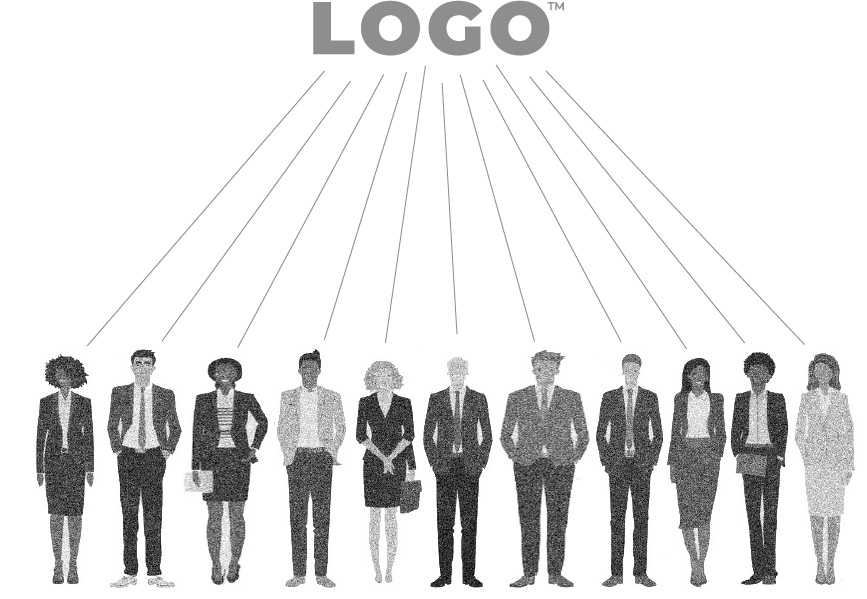When you think of a brand, a logo often comes to mind first. It’s the visual symbol that represents a company, appearing on everything from business cards to websites. But let’s be clear: a logo, while important, is not the brand itself.
At Re:brand, we believe that a brand is a strategic asset that drives business, not just a visual element. A good logo plays a crucial role, but its value goes far beyond its appearance. In this post, we’ll explore what makes a good logo and why it’s more than just a pretty face.
A logo as a strategic gateway
A logo is often the first point of contact between your business and potential customers. It sets the stage for the entire brand experience and serves as a gateway to understanding your brand’s identity.
However, a logo alone cannot communicate everything about your business. Its real value lies in its ability to encapsulate and convey your brand’s core values, promise, and personality in a single, memorable symbol.
A good logo should be simple, memorable, and versatile—able to work across various mediums and sizes. But more importantly, it must be strategically aligned with your brand’s identity and business goals, resonate with your target audience, and reinforce your market positioning.
That is why, when we work with our clients on logo design, we don’t start with sketches and colours; we start with questions. What are your business goals? Who is your target audience? What challenges are you facing in the market? The answers to these questions inform the entire branding process, and therefore the creation of the logo.
Our approach ensures that the logo we create is not just aesthetically pleasing but also serves as a strategic purpose that drives your brand and business forward.
The creative anatomy of a ‘good logo’
Once we’ve established a solid strategic foundation that aligns with your brand’s identity and goals, we can begin the creative process. Most of the time, this process follows key principles that contribute to the effectiveness of a logo, ensuring it not only looks good but also resonates with the audience.
So, what makes a good logo design?
- Simplicity: A good logo is simple and uncluttered, making it easy to recognise and remember. Think of the iconic apple (Apple) or tick (Nike) – each uses minimal elements to convey a powerful brand message.
- Memorability: A memorable logo is meant to leave a lasting impression. It should be distinctive enough to stand out but not so complex that it’s easily forgotten. Achieving memorability often comes from unique design elements, clever use of negative space, or a strong visual metaphor that encapsulates the brand’s essence. Think Starbucks mermaid, for instance.
- Relevance: The design of the logo must be relevant to the brand’s audience, but also fit within at least some of the industry expectations. A good logo uses colours, typography, and shapes that reflect the brand’s personality and appeal to its target market. For example, a tech company might use clean, modern lines to convey innovation, while a children’s brand might use playful or muted colours and rounded shapes.
- Timelessness: A good logo should be designed with longevity in mind. While it’s tempting to follow design trends, a logo that relies too heavily on current fads may quickly become outdated. Timeless logos, like Coca-Cola for instance, have remained relevant for decades because they are rooted in the brand’s core identity rather than transient design trends. And their ‘refresh’ to keep them aligned with their time always stays true to their core.
- Versatility: A logo must work across various applications, from digital screens to print, and in both colour and black-and-white formats. This versatility ensures that the logo maintains its integrity and impact no matter where it’s used. A well-designed logo should also be scalable, retaining its clarity and recognisability at any size, ensuring it looks just as good on a small business card as it does on a large billboard
While there are times when taking a bold, unconventional approach is necessary to stay true to the strategy and create differentiation, these design principles generally ensure that the logo becomes more than just a visual mark—it becomes a powerful tool that resonates with your target audience and drives your business forward.
Refreshing the existing: Logo continuity or renewal?
Not all logo projects start from scratch. Often, businesses find themselves in a position where their current logo needs an update to stay relevant in a changing market, or they may be rebranding with a new name but want to retain some of the brand equity built over time.
The challenge in these situations is to strike the right balance between maintaining continuity with the existing brand and introducing a fresh, modern design that resonates with yesterday’s, today’s but also tomorrow’s audience.
That’s why, when we work on updating a logo, our goal is generally to modernise and revitalise it while keeping the elements that customers already associate with the brand.
This could mean retaining specific colours, shapes, or fonts that are integral to the brand’s identity. By doing so, we ensure with our clients that the refreshed logo still feels familiar to their audience, preserving the trust and recognition that had been established over the years.
Updating a logo or creating a new logo for an updated brand requires a thoughtful approach that respects the brand’s heritage while embracing the business renewed objectives. In short, it’s all about evolving with purpose, introducing changes that position your brand for your business future growth. And that’s what creative work should always work by.
Conclusion:
A logo is not just a visual marker; it is a strategic tool that should align with your business goals and reflect your brand’s true essence. It’s a promise to your customers, representing the quality, values, and experiences they can expect from your brand.
A good logo is therefore essential, but it’s only part of the brand story.
The best logos also incorporate thoughtful design elements that ensure they are not only visually appealing but also effective in conveying your brand’s message.
At Re:brand, we believe in building brands that drive business success, with logos that play a meaningful role in that process. If you’re ready to create a brand that truly resonates, let’s talk. Reach out to us today to start the conversation.
About the Authors: Adam Errington & Sarah Bonnefoy
Adam Errington, our creative director based in Wellington, and Sarah Bonnefoy, our senior brand strategist based in Auckland, bring a wealth of expertise to Re:brand.
With 28 years of experience in advertising, visual identity, and Māori design, and over 15 years of expertise in brand building and marketing for major brands, they regularly combine their strengths to share insightful industry perspectives.






